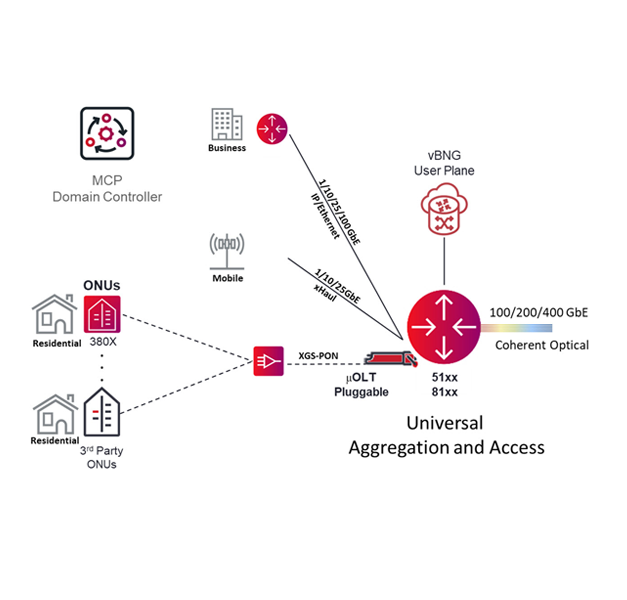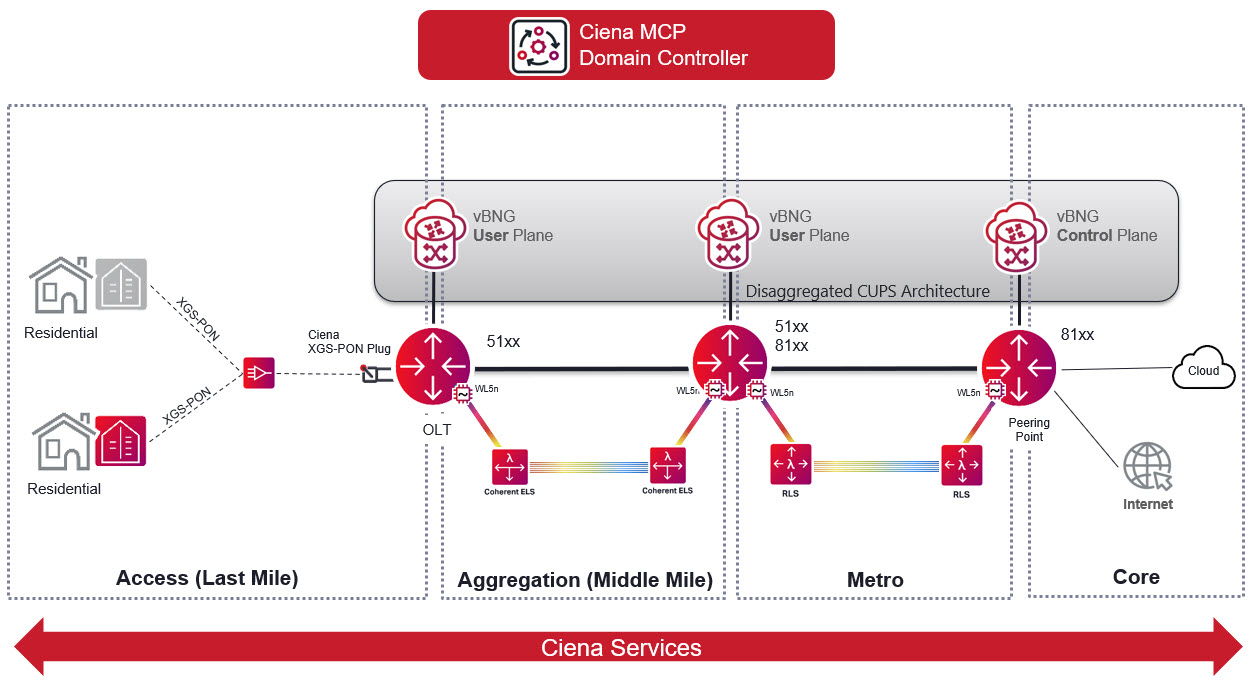Ciena's disruptive broadband access architecture
We’re at a pivotal moment in the residential broadband market. The global pandemic forced people to work, learn, play, and socialize from home that emphasized the criticality of affordable, ubiquitous, and reliable broadband network access to communities around the world. It also accelerated several broad market shifts already underway, including a strong migration of residential/personal applications to the cloud, and the rise of the home as the new company branch office.
 These changing dynamics have given rise to greater demands being placed on our residential broadband services such as reliability, ubiquity, sustainability, symmetry, lower latency, affordability, and of course higher performance. However, it’s doubtful today’s residential broadband network infrastructure can deliver all of these performance requirements.
These changing dynamics have given rise to greater demands being placed on our residential broadband services such as reliability, ubiquity, sustainability, symmetry, lower latency, affordability, and of course higher performance. However, it’s doubtful today’s residential broadband network infrastructure can deliver all of these performance requirements.
For years, broadband solutions served a fairly narrow and straight-forward focus of providing best-effort, asymmetrical services serving as many customers as possible in densely populated areas. This traditional mindset drove the development of chassis-based solutions with dedicated circuit packs in a proprietary environment resulting in solutions with limited flexibility and scalability hindered by incremental innovations reinforced by a closed business model.
Unfortunately, “pizza box” platforms available today follow these same legacy design principles, albeit in a smaller physical footprint. This approach was acceptable in the past but not anymore. It’s clear this new residential broadband moment in time demands an entirely different solution – a disruptive network architecture.
Episode 56: Igniting a Digital Future for All with Improvements in Residential Broadband
A Blueprint for Next-Generation Broadband Architecture
To be clear, we’re not proposing a complete network overhaul, but for network operators evolving from legacy technologies like DSL, DOCSIS, or older PON, it’s time to embrace a disruptive mindset. Concepts like openness, modularity, and scalability must be at the core of any new broadband architecture design. This provides an efficient and sustainable infrastructure best adapted to users' future application requirements while protecting existing network investments.
It all starts with broadband access technology. An Optical Line Terminal (OLT) solution based on feature-rich and highly scalable routers that leverage µOLT pluggables is essential to a next-generation broadband architecture. This equips network operators with a fiber-based solution allowing them to grow with the number of users, bandwidth, and performance in an agile and cost-efficient way. The result? Ensuring long-term competitiveness and sustainability.

Figure 1: A fiber-based next-gen broadband network access architecture
Infrastructure monetization is a crucial part of any successful business meaning the solution must be flexible enough to support the core business and expand to adjacent markets quickly when a business opportunity emerges. For example, network operators focused on residential broadband need access technology that supports a high-density XGS-PON µOLT pluggable.
For example, suppose an enterprise needs dedicated ethernet connectivity, or a Mobile Network Operator (MNO) needs xHaul (fronthaul, midhaul, backhaul) wholesale services. In this case, the network infrastructure must allow the service provider to take advantage of these opportunities without deploying additional platforms or replacing the existing infrastructure.
Another key capability network operators must prioritize is the integration of OLT and aggregation functionalities onto the same platform. Routers with a high-capacity switching matrix that goes beyond XGS-PON µOLT pluggables to support multiple high-speed 100/200/400 Gb/s coherent optical pluggable Network-to-Network Interfaces (NNI) enable network operators to move the µOLT closer to end users.
This reduces space and energy requirements, while providing the scalability and performance required to create a futureproof and sustainable solution. It also allows network operators to explore the remote µOLT concept by extending their network reach quickly and flexibly. Having hardened and weatherized platforms enable network operators to choose where to implement network assets without worrying about costly and complex climatization capabilities by using a simpler and smaller external cabinet.
Network openness is another vital aspect to consider. Creating a best-in-breed, future-proof network based on closed and proprietary technologies is impossible. The speed at which new applications emerge makes it impossible for any single technology supplier to provide the latest features needed in all the building blocks that comprise an end-to-end broadband network.
Investing in solutions from a technology partner that’s open to integrating with other vendors' components, such as Optical Network Unit (ONU) / Optical Network Terminal (ONT), WiFi gateways, analytics software, and so on, gives network operators the peace of mind. They can use the best solution available to both support their unique and specific customers' performance requirements for even the most demanding applications.
Network operators wanting to be competitive in the broadband market must also ensure their Middle Mile (also called aggregation) network is highly flexible and scalable. Coherent routing is a key architectural concept that augments router capabilities with scalable coherent optics that works seamlessly with an optical line system to create a converged IP/Optical solution.

Figure 2: An end-to-end broadband network architecture
A disruptive broadband architecture goes beyond hardware
Another critical element of a broadband network is the subscriber management system, commonly known as a Broadband Network Gateway (BNG). Legacy implementations have relied on capabilities embedded in routers at the network core. This model was suitable for supporting basic internet applications, but cannot offer the scalability and reliability or performance the new applications demand.
A next-generation broadband architecture will need to embrace concepts like virtualization and disaggregation in order to deliver new services cost-effectively, and this starts with rethinking the BNG. A virtual BNG (vBNG) can be installed on Commercial Off-The-Shelf (COTS) servers, or in the cloud, enabling deployments to begin small and quickly scale when needed.
The crucial architectural change enabling a virtual BNG is the adoption of a Control and User Plane Separation (CUPS) model. CUPS allows network operators to move the User Plane closer to their customer to improve network and application performance, while the Control Plane stays centralized for cost efficiency and simplification of management.
On the operational side, having a domain controller solution that simplifies network operations while increasing network agility is paramount to a successful broadband business. This facilitates the management and operations of an end-to-end broadband network infrastructure using a single platform, including support for multiple layers, multiple services, and even ONU/ONT from different vendors.
Few things matter more than sustainability
In this new market reality, the importance of environmental and economic sustainability cannot be neglected or treated as an afterthought. It is now crucial in defining competitiveness and how solutions align with end-user values. Sustainability can be applied to a dynamic broadband access architecture in a number of ways:
- Power and space-optimized solutions that are scalable and flexible to support application and customer needs longer, perform multiple functions, and deliver multiple services in a cost-efficient, converged way.
- Temperature-hardened or weatherized platforms supporting challenging deployment scenarios without needing climatization can improve network performance and simplicity while reducing cost, power requirements, and time-to-revenue.
A partner to turn concepts into reality
Properly implementing the ideas covered in this blog—from concept to reality―is what will ultimately drive customer success, and this journey requires its own skillsets and expertise.
If this is new territory for your team, you’ll want to consider a partner with strong solution design service capabilities. They should address the long-term analysis of all phases of your network and technology planning, as well as defining what constitutes operational excellence. They should also cover high-level design and low-level design, configuration templates, acceptance test plans, and other important deployment tasks.
Of course, once implemented, be sure your partner can support, manage, and optimize your broadband network for the long term.



